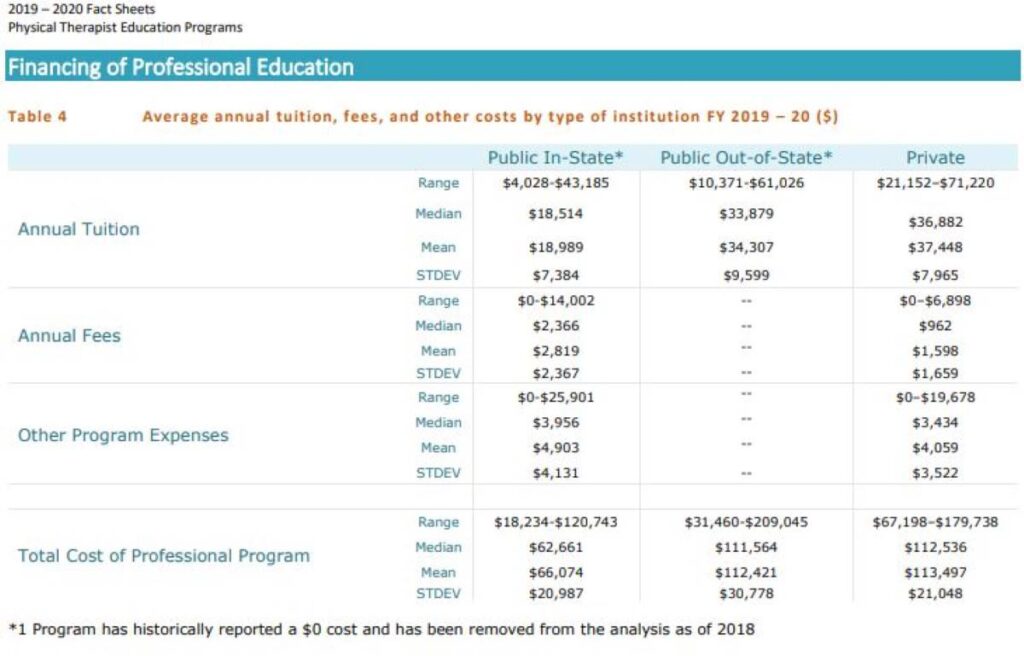The state of New York has the most physical therapy schools within it compared to any other state within the US. There are a total of 21 physical therapy schools within the state of New York. All of these schools are CAPTE-accredited. If you’re looking for more specifics for each of these schools, keep reading.
This high number of schools can be surprising news for many since it’s not the largest geographical state. New York is however America’s fourth most populous state, making it practical for a high number of schools. The high number of schools can be a very favorable statistic for PT applicants living in New York and wishing to stay in-state throughout their schooling or wishing to live at home throughout the process.
I have comprised a chart below to help give you a quick visual overview of the unique PT-related features of each school
Other questions I will be addressing within this article:
- What are the benefits to having a high number of PT schools within one state
- What are the drawbacks to having a high number of PT schools within one state
Location of PT schools throughout the state of New York
What are the benefits to having more PT schools within a single state?
If you’re considering heading into PT school, there are some great benefits to having a large number of PT schools within a single state, especially if this state is where you live. For starters, if you reside within this state (New York, for this example), you have many more options available for staying in-state while obtaining your education, which means you could save some serious, serious money as a result.
A higher likelihood of being accepted to a school in-state and saving on tuition costs as a result
Academic institutions across the US typically have different tuition rates for students based on whether or not they are originally living in that state (an in-state student) or if they have moved from another state in order to attend that institution (an out-of-state student). In-state tuition rates are much cheaper for students than out-of-state tuition rates.
According to a 2019 Aggregate Data Report by the The Commission on Accreditation in Physical Therapy Education (CAPTE), the median annual tuition rate at public institutions for in-state students for 2019-2020 is $18,514 while the median annual tuition rate for out-of-state students is $33,879. That’s an annual difference of $15,365!!! Considering that a Doctor of Physical Therapy program is three years in academic length, that’s a total of $46,095 difference!!!
If being able to save that much money by staying in-state for PT school isn’t a major benefit, then I don’t know what is.

The potential to live at home or not have to move to a new living quarters, saving money and time
In addition to saving serious money from tuition, you may have a higher chance of continuing to live at home. This of course depends on all sorts of unique factors to each individual, but for students who have the option to live at home with their parents, this can again help to save a large amount of money through factors such as paying little or no rent, not having to buy household items for an apartment, etc.
What are the drawbacks to having more PT schools within a single state?
One of the major drawbacks to having a high number of PT schools within a state is the increase in market saturation if looking to gain employment within the state after graduating. A second challenge is for physical therapists who are considering opening a private practice within the area.
Increased market saturation leads to fierce job competition for new PT graduates
With a higher number of PT schools within any given area comes a higher number of PT graduates who must then look for employment. While not all students who graduate from PT school within New York wind up staying within the state, many do, or would at least like to.
For the students wishing to stay in state when entering clinical practice, this means that they now have increased competition when it comes to finding employment. This is especially true for areas of the state (such as upstate New York) in which there is substantially less general population to be treated but a higher number of PT schools.
Consider Buffalo, New York (where I attended PT school). The city of Buffalo has three PT schools (University at Buffalo, Daemon College and D’Youville College), and just up the road in Rochester (Nazareth College) is another PT school.
With the CAPTE’s Aggregate Data Report showing that the mean class size for each PT cohort being 45 students, that’s approximately 180 students in this general region graduating each and every year now looking for work. Granted, not all of them will stay in Western New York or even the State of New York, but a large portion of them likely will, which keeps the market rather saturated for the area.
Increased clinics within the area leads to increased competition for private practice owners
One major threat for physical therapists who are considering entering private practice or physical therapists who are considering opening up their own private practice is the increased competition within a heavily saturated area.
With increased market saturation comes increased threats to an individual business. While market saturation is desirable for the patient seeking treatment, it’s not desirable for the practice owner. The more options that a patient has access to, the less likely they are to come to you (or stay with you) for your services. This can in turn lead to decreased practice revenue, affecting the clinic or facility owner to a great extent.
It’s also not desirable for a therapist who works at such a clinic, even if they are not the practice owner. Building and sustaining a full caseload now becomes more challenging, and if the therapist is being paid on a case-basis, it can cut into their earnings as a result. For therapists who earn their income via a case-by-case basis, building and sustaining a full-time caseload becomes much more challenging due to increased local competition.
Concluding remarks
With the state of New York having at total of 21 CAPTE-accredited schools within its borders, there are no other states that currently trump this number. Though the PT curriculum will be kept rather standard for each school (across the US – not just for the state of New York), each school has its own set of academic requirements that must be fulfilled by PT applicants wishing to attend a particular institution.
There are some great benefits to having a large selection of PT schools within a single state, especially for applicants who are from or currently reside New York. This large selection can help afford them a higher chance of applying to (and being accepted) at school within the state, which can help save them tuition fees and perhaps allow them to continue to live at home while completing their PT program.
Drawbacks also exist however, when referring to an increased number of schools within a single state. The biggest drawback is likely to be found for graduates who wish to stay in-state when entering practice. The drawback comes from a high market saturation, which can make competition for employment for new graduates quite fierce.
Just as concerning is the challenge that is created for physical therapists wishing to open up private practices. Increased competition within the surrounding area can make it tougher to turn a profit and keep the clinic operating within desired profit margins.
Like anything else, there are pros and cons for applicants to having a large selections of PT schools within a single state. Whether the pros outweigh the cons or vice versa will ultimately come down to the personal belief of each PT applicant.
Related articles

Hi! I’m Jim Wittstrom, PT, DPT, CSCS, Pn1.
I am a physical therapist who is passionate about all things pertaining to strength & conditioning, human movement, injury prevention and rehabilitation. I created StrengthResurgence.com in order to help others become stronger and healthier. I also love helping aspiring students and therapists fulfill their dreams of becoming successful in school and within their clinical PT practice. Thanks for checking out my site!

